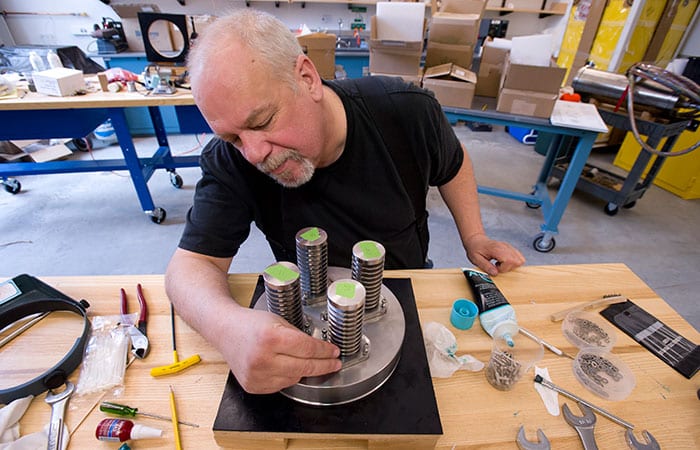
Rebuilding Alvin: Will Sellers
A series on the people reassembling the iconic sub
Since the beginning of 2011, Alvin, the U.S. science community’s only human-occupied submersible dedicated to deep-sea research, has been undergoing a thorough overhaul and upgrade that will enhance its capabilities. The improvements include a new personnel sphere, updated command-and-control systems, enhanced lighting and high-definition imaging systems, new syntactic foam to provide buoyancy, and more and larger viewports, or windows.
The centerpiece is a larger personnel sphere with improved interior design to enhance the comfort of pilots and researchers who will occupy it. The titanium sphere is also designed to withstand pressure at depths of 6.5 kilometers (4 miles), with the eventual goal of allowing Alvin to dive beyond its current 4.5-kilometer (2.8-mile) diving capacity.
Now in the final stages of the first phase of the upgrade, the iconic sub is being painstakingly reassembled, piece by piece, by a one-of-a-kind team of engineers, technicians, and pilots at Woods Hole Oceanographic Institution (WHOI). They also carefully inspect and test each component to ensure its reliability and the safety of those who will use to sub to explore the depths.
Here, engineering assistant Will Sellers describes the devices that keep Alvin‘s electronics from overheating:
These are radiators called ‘CoolPlugs™.’ This cap fits onto titanium bottles that contain the sub’s electronics. Inside these pipes are heat pipes—copper tubes partially filled with an alcohol-water mixture that goes through two holes in the cap and then into the electronics bottles. The bottles ride outside the personnel sphere, mostly in the very back of Alvin.
You’ve got a lot of things going against you here. Titanium is such a great metal to use for one thing and lousy for another. It is a horrible heat-transfer material. It doesn’t like to transfer heat. So it can get really warm inside that electronics bottle.
All the heat that’s generated by the electronics gets run out into these radiators. The alcohol-water mixture absorbs the heat and evaporates. The vapors travel to the CoolPlug™ radiators, which have cold seawater surrounding them. That condenses the vapor back into a liquid, releasing the heat. So it keeps everything inside the electronics bottles nice and cool.
A lot of the overheating occurs while the sub’s on deck. You’ve got to fire it up and test it, and run it on deck. But subsea, you’re going to be working those electronics really hard.
[The blue goop in the tube on the right] is Aqua-Lube. Every screw that’s exposed to salt water has got Aqua-Lube on it. Every time. It prevents galling. You’re putting stainless steel screws into a titanium end-cap, and if the threads aren’t exactly right, galling is when they get so hot that they actually become one. You’ll never get them undone after that. The Aqua-Lube prevents that from happening.
And then on other parts, there’s LocTite [in the small red tube on the left]. LocTite is normally used for parts that really aren’t going to see salt water. You put it on threads so that once you drive the screw home, it dries and it locks the threads in place. But this is a removable thread-locker, so you can take a wrench and back it out. But that screw is not going to back out by itself.
Electro-mechanical is my specialty. The Alvin project has kept me busy since December. This is the fourth Alvin overhaul I’ve been involved in. I started here in ’82 as a technician, became an Alvin pilot, and then after about five years, I went over to the group operating the remotely operated vehicle Jason and was chief pilot-expedition leader for 22 years.
All the vehicles are on the same basic principle. Because you’re bringing things out to sea, it’s all the KISS principle—Keep It Simple, Stupid. If you make it too complicated, if something goes wrong out there, you’re not going to fix it like that [snaps fingers] and get right back in the water. But, there’s certain things that can’t help but be complicated. Like Jason’s telemetry system, or fiber optics. You need some good people out there with you.
Alvin is owned by the U.S. Navy and operated by WHOI. The current upgrade has been funded largely by the National Science Foundation, with support from private donations to WHOI.
From the Series
Related Articles
- The story of a “champion” submersible
- Robots to the Rescue
- Who is Alvin and what are sea trials?
- 7 Places and Things Alvin Can Explore Now
- The story of “Little Alvin” and the lost H-bomb
- Meet the Alvin 6500 Team: Lisa Smith
- Overhaul to take Alvin to greater extremes
- Meet the Alvin 6500 Team: Rose Wall
- Racing an undersea volcano
Featured Researchers
See Also
- Building the Next-Generation Alvin from Oceanus magazine
- Alvin Gets an Interior Re-design from Oceanus magazine
- New Personnel Sphere Passes Pressure Test WHOI News Release
- Human Occupied Vehicle Alvin
- Alvin's Pilots from Oceanus magazine
- National Deep Submergence Facility
